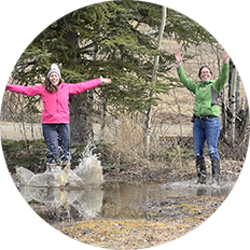
Wild Spring Adventure!
6 minute read (and/or) watch the video!
It’s a time of birds migrating. Some, like swans, stop only a short time on their way to nesting grounds further north; some stay for the season, like the chickadee and bluebird – they build nests, attract mates and raise their families.
There’s a saying – “Spring is in the air” – that implies a renewal of spirit and perhaps a bit of friskiness in certain species, like Red Foxes, that may lead to becoming parents to this year’s young (or perhaps they already ARE parents!). Of course, some species breed in the autumn, so that as spring progresses, we will start to see babies being born – at Yukon Wildlife Preserve we are hopeful that we will see Bison, then Caribou calves in the coming weeks and months. We expect to see wild fox kits and ducklings as well.
At the Preserve, Arctic Ground Squirrels started popping their heads above ground April 7 this year, with the males the first to break their winter hibernation. Juveniles and females are soon to follow their lead. We see, sitting on the cliffs and soaring above fields, birds of prey like bald eagles, coming in to hunt this prolific prey species. Spring is a notable return of the constant cry of alarm calls of ground squirrels, as their many predators hunt them from land or sky – displaying the full Circle of Life.
New growth has begun with grasses and early flowers like crocuses, to name only two plant species. This is important nutrition to many animals after a long cold winter, and grazers like Thinhorn Mountain Sheep can be found on south facing slopes, enjoying the tender new shoots, and the ease of eating, now that the deep snow has melted.

Crocuses are one of the first signs of spring – and important nutrition to many animals after a long cold winter. Here we see a very early crocus found by the authors on their spring adventure hike at Yukon Wildlife Preserve. Photo by Lindsay Caskenette

Swans have a long migration in the spring – open water at Yukon Wildlife Preserve is a frequent stop over for food and rest by migratory birds. Some, like bluebirds, stay for the season, some, like the swan, typically move on to nesting grounds further north. Photo Lindsay Caskenette
When you need a meal, sometimes you have to “spring” into action. Lynx are natural jumpers and we took the opportunity to provide enrichment to our resident lynx females by placing their food in trees. In the wild, lynx prefer snowshoe hare and will use powerful leaps to catch their meal within only a few “springs”….we mean jumps…..
Limited smells in winter mean that spring unearths a plethora of new scents on the air. Red Fox have an excellent sense of smell, making it easy for them to follow their nose to food sources. When they’ve eaten their fill, they will cache extra food as snacks for later. They keep an eye and ear out to avoid anyone following them to their cache site – other foxes and many birds in the Corvidae Family – grey jays, magpies, and ravens are known to steal their snacks.
Whether you’re human or animal, winter coats are shedding – and that wool, hair and fur can be found on the environment – rocks, trees, and fences (and sometimes finds its way into lining the nests of birds and small mammals like ground squirrels…..) Shedding coats leads to a period of time not known for its fashion sense….and much shagginess in animals like bison.
Winter is over and the cycle of the year continues. Spring arrives, bringing increased sunlight and changes in everyone’s behaviour and appearance – humans and animals alike. We shed layers, feel the sun on our faces, enjoy the smells and the sounds of life renewing around us. We experience a rejuvenation of our spirits. Be well and enjoy spring, wherever you are.

Lindsay Caskenette & Julie Kerr
Visitor Services Manager and Visitor Services Coordinator
Lindsay and Julie love to share the Preserve the same way they explore life – full on and full of adventure! They have a collective love of: Animals....Lindsay dogs, Julie foxes; Adventure.... Lindsay dog mushing, Julie extreme camping; both take on animal personas during story telling. Together they support the Preserve with a strong Visitor Services presence and often, they even get work done (this happens most often when the other one is out of the office).

That was fun. Thanks, Lindsay and Julie – we hope to see you again soon!
Thanks Murray! We had a lot of fun sharing spring at the Preserve with everyone. We hope we’ll be able to see you soon.
This is amazing! Surely denotes spring! A nice catch up when physical presence isn’t possible. Thanks for sharing!
Thanks Valerie – nothing says spring at the Preserve like bluebirds, swans and mud puddles! We’re glad you joined us on our Adventure and enjoyed.
My daughter and I were pretty amazed at how high that lynx could jump. I think her exact words were “wow”.
I enjoy reading your articles so much, Julie. They are so descriptive that I can see in my minds eye exactly what you are talking about. One thing that I have found helpful during this time of uncertainty is trying to find the beauty in simplicity. Taking time just to look at things in the natural world is very calming to the soul. Your articles are a reminder to me to practice mindfulness.
Thanks Deidra. We’re glad you find nature as good for the soul as we do. Thanks for joining us and as for lynx, I agree with your daughter – WOW!